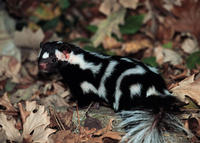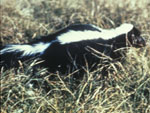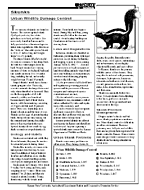Skunks
 Two species of skunks are found in Kansas. The eastern spotted skunk (Spilogale putorius) has white splotches on its back and sides. It is now rarely found in Kansas and is fully protected as a threatened species under state regulations. Also known as the "civit cat," the adult spotted skunk is 14 to 22 inches long and weighs from ¾ to 2 ¾ pounds.
Two species of skunks are found in Kansas. The eastern spotted skunk (Spilogale putorius) has white splotches on its back and sides. It is now rarely found in Kansas and is fully protected as a threatened species under state regulations. Also known as the "civit cat," the adult spotted skunk is 14 to 22 inches long and weighs from ¾ to 2 ¾ pounds.
The striped skunk (Mephitis mephitis) is more common. It has shiny black fur with two white stripes down its back. Striped skunks have varying amounts of white on the head, back and tail. Adults are from 20 to 30 inches long, including the tail, and usually weigh between 3 ½ and 10 pounds.
 Striped skunks' musk has a characteristic pungent odor. These shy, secretive animals discharge their scent only when disturbed or harassed. They are the least popular of all wild animals, yet they are beneficial because nearly half of their diet is insects, with the remaining consisting of 20 percent fruit and 20 percent mice. Diets vary depending on a skunk's location and the time of year. Skunks eat the eggs of ground-nesting birds, biting off one end, licking out the contents and leaving the shells more or less together in the nest. Spotted skunks do not crush the egg shells as much as striped skunks do.
Striped skunks' musk has a characteristic pungent odor. These shy, secretive animals discharge their scent only when disturbed or harassed. They are the least popular of all wild animals, yet they are beneficial because nearly half of their diet is insects, with the remaining consisting of 20 percent fruit and 20 percent mice. Diets vary depending on a skunk's location and the time of year. Skunks eat the eggs of ground-nesting birds, biting off one end, licking out the contents and leaving the shells more or less together in the nest. Spotted skunks do not crush the egg shells as much as striped skunks do.
Skunk Odor Control
Skunk odor is difficult to neutralize and persists for a long time. Household products that help remove skunk odor include ammonia, bleach, vinegar, washing soda, laundry soaps, smoke from a citronella candle and canned tomatoes or tomato juice. WARNING: do not mix ammonia and chlorine bleach. This combination may form a gas (chloramine) that is toxic if inhaled, even in small amounts.
Some old-time remedies include burying fouled garments in the soil for a few days and then letting them air out; subjecting clothing to smoke from burning leaves, especially cedar or juniper foliage; and exposing clothing to car exhaust. But remember, it is DANGEROUS to run a car in a closed garage.
Another deodorizing solution that you can mix from readily available ingredients is as follows:
1 quart 3% hydrogen peroxide
1/4 cup baking soda
1 teaspoon liquid soap
Mix ingredients well and thoroughly saturate the areas the skunk has sprayed. Use immediately and do not store the mixture or keep it in a glass container. It expands and will break sealed containers. Be aware these solutions may cause color changes in certain materials. In treating pets, keep solutions away from their eyes.
Commercial deodorants such as Neutroleum Alpha are masking agents that are effective for reducing skunk odors. Neutroleum Alpha is available from some pest-control operators or may be obtained by writing the manufacturer and requesting a list of local sources. When using chemicals, always read and follow label instructions.
Skunk Control
Skunks: Urban Wildlife Damage Control
